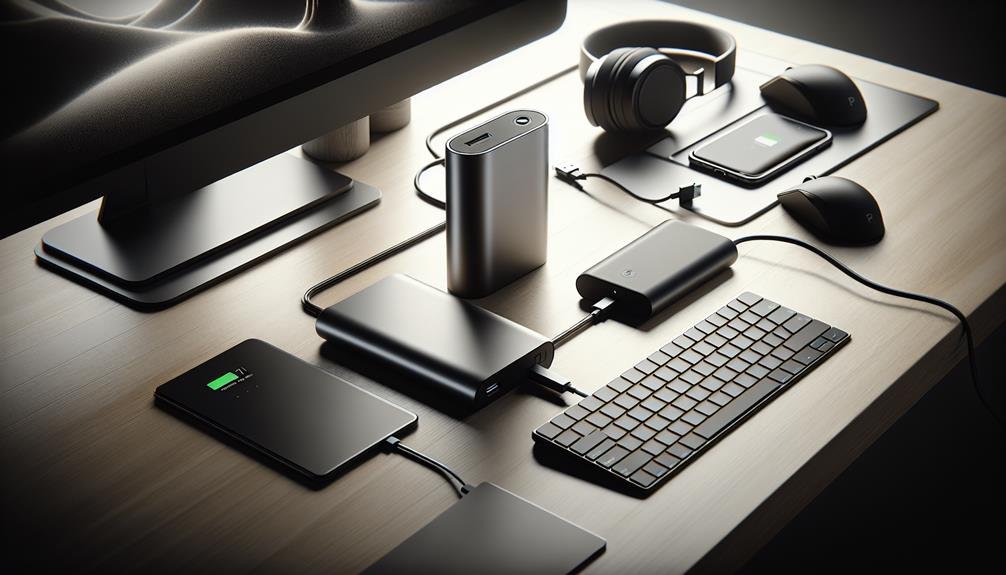Charging one power bank with another isn't recommended, though it's technically possible. This process is highly inefficient due to energy transfer losses, voltage regulation mismatches, and potential overheating risks. Additionally, repetitive charging between power banks can accelerate battery degradation, reducing their overall lifespan. Power banks are designed primarily for output, not reciprocal charging. Using them for this purpose could lead to safety issues like overloading and excessive heat buildup, as well as compatibility malfunctions. To maximize efficiency and safety, always use proper charging devices. Interested in more details? There's plenty more to uncover.
Understanding Power Bank Basics
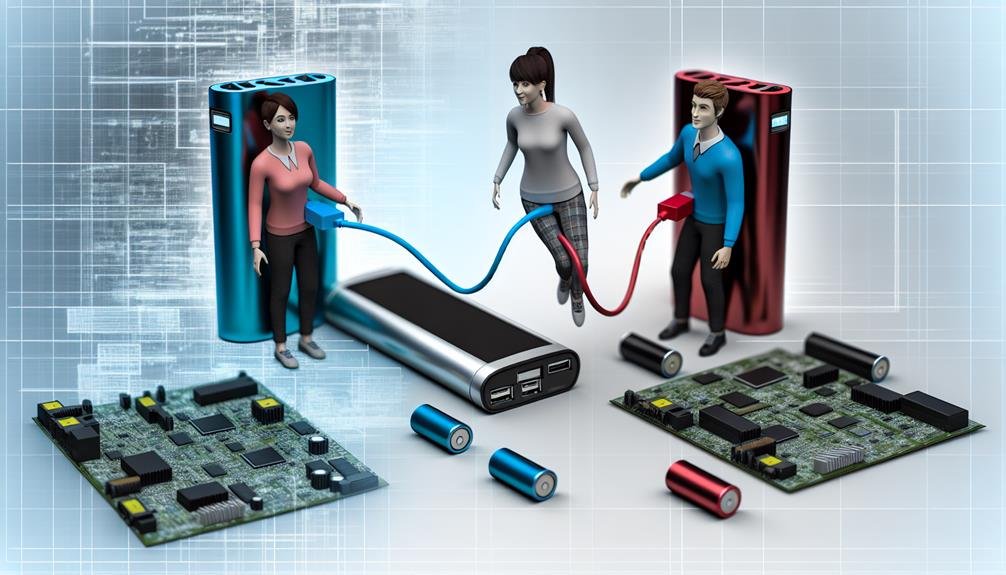
To fully comprehend the intricacies of charging a power bank with another power bank, you must first understand the basic principles of how power banks operate. Power banks are essentially portable batteries designed to charge electronic devices like smartphones and tablets. They store electrical energy and release it when connected to a device. However, when considering charging one power bank with another, several crucial factors come into play.
First, charging compatibility is paramount. Not all power banks are designed to be inter-compatible. Check the specifications of both power banks to make sure they can safely interface. The power bank capacity is also vital. If you're using a smaller capacity power bank to charge a larger one, it may not be efficient and could potentially strain the smaller unit.
Next, consider the charging speed. Power banks often have varying input and output rates. Charging one power bank with another might result in slower charging speeds, which could be inconvenient. Additionally, improper charging practices can negatively impact the power bank lifespan. Overloading the power bank's circuitry or using incompatible devices can lead to overheating, potentially shortening the useful life of both units. Always follow manufacturer guidelines to ensure safe and effective operation.
How Power Banks Work
Power banks function by storing electrical energy in rechargeable lithium-ion or lithium-polymer batteries, which can then be used to charge other devices. These batteries utilize advanced battery technology to provide efficient and portable charging solutions. When you connect your device to a power bank, the stored energy is transferred through a circuit that regulates voltage and current, guaranteeing your device receives the appropriate charge.
Consider the following breakdown of power bank components and their functions:
| Component | Function | Safety Considerations |
|---|---|---|
| Battery Cells | Store electrical energy | Use quality cells to prevent overheating |
| Control Circuitry | Manages charging and discharging | Prevents overcharging and short circuits |
| Input/Output Ports | Connects power bank to devices | Verify ports are undamaged and clean |
| LED Indicators | Displays charge status | Inspect indicators for correct functioning |
| Enclosure | Protects internal components | Use fire-resistant materials |
The key to effective portable charging lies in the balance of capacity, efficiency, and safety features. High-quality power banks often include multiple safety mechanisms, such as overcharge protection, short-circuit prevention, and temperature control. By understanding these components and their roles, you can make informed decisions about which power bank best meets your needs while ensuring secure operation.
Charging Mechanisms
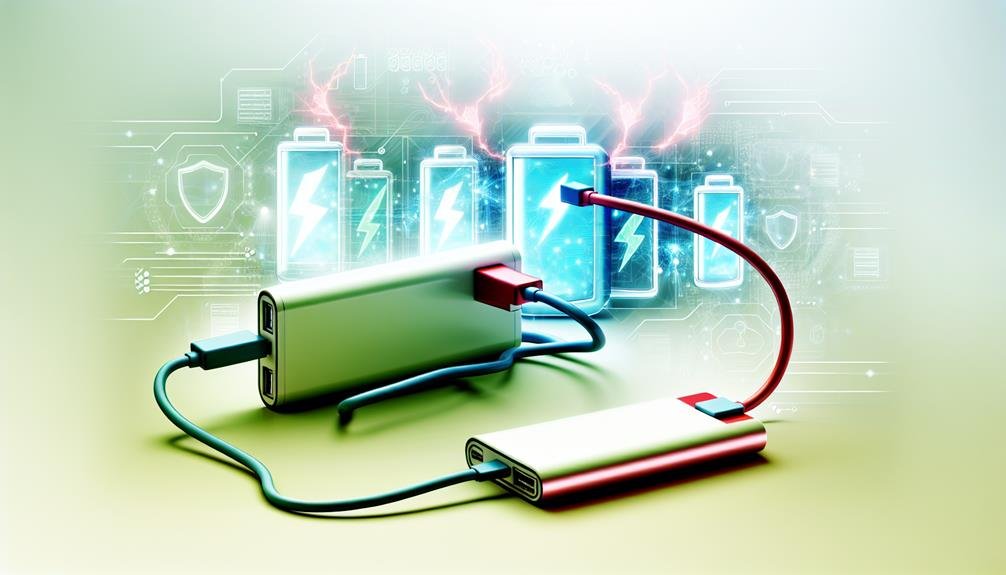
When charging a power bank with another power bank, you'll need to understand the role of USB input/output ports, power transfer efficiency, and the potential risks involved. It's important to analyze how efficiently power is transferred between devices and consider any safety concerns. Let's explore these mechanisms in detail to achieve best performance and safety.
USB Input/Output Ports
You'll find that USB input/output ports are vital components for the charging and discharging processes in power banks. Understanding these ports is necessary to guarantee charging compatibility and avoid potential hazards. When you're looking to charge a power bank with another power bank, examining the USB input and output ports is a necessity.
Here are three key points to keep in mind:
- Charging Compatibility: Make sure that the input port on the power bank being charged matches the output port on the charging power bank. Common USB types include USB-A, USB-C, and Micro-USB. USB-C ports are increasingly popular due to their capability to handle higher power levels and transfer speeds.
- Output Limitations: Confirm the output current and voltage specifications of the charging power bank. Going beyond the input limitations of the receiving power bank could result in overheating or even damage. Most power banks have output ratings like 5V/2A or 9V/2A, which should be matched appropriately.
- Safety Protocols: Look for power banks that include safety features like overcharge protection, short-circuit protection, and temperature control. These features are essential when engaging in complex charging setups, such as daisy-chaining power banks.
Power Transfer Efficiency
Understanding the efficiency of power transfer mechanisms is crucial for optimizing the charging process between two power banks. When you try to charge one power bank with another, energy efficiency becomes a critical factor. During this process, some energy is inevitably lost as heat due to the inherent inefficiencies in the electronic components. This loss increases with each step in the power conversion process, reducing the overall energy efficiency.
To maximize efficiency, it is important to use power banks that support high-efficiency charging protocols like Quick Charge or Power Delivery. These technologies minimize energy loss and improve charging speeds. However, you must also consider safety precautions. Make sure both power banks are designed to handle bidirectional charging safely. Mismatched voltage or current levels can lead to overheating, posing a safety risk.
Furthermore, always use high-quality cables that are rated for the specific power requirements of your devices. Poor-quality cables can further degrade energy efficiency and introduce additional safety hazards. By being meticulous about these factors, you can maintain higher energy efficiency and adhere to crucial safety precautions when charging one power bank with another.
Potential Risks Involved
Despite optimization efforts, several potential risks arise when charging one power bank with another, primarily due to the complexities inherent in the charging mechanisms. Understanding these risks is essential for ensuring safe and efficient charging practices. Here are the primary concerns:
- Connectivity risks, Power loss concerns: When you connect two power banks, the quality of the connection can greatly affect performance. Poor connectivity might lead to unstable power transfer rates, resulting in inefficient charging and potential power loss. This not only prolongs charging time but also increases the risk of overheating and damaging the devices.
- Compatibility issues: Not all power banks are designed to be compatible with one another. Differences in design, technology, and power management systems can lead to suboptimal charging conditions. If two power banks aren't compatible, you could face irregular charging patterns or even complete failure to charge.
- Voltage mismatch: Voltage differences between the two power banks can be risky. If one power bank outputs a higher voltage than the other can handle, it could lead to overvoltage issues, potentially damaging the internal circuitry of both devices. Such mismatches can also increase the risk of electrical fires.
Feasibility of Charging
Evaluating the feasibility of charging one power bank with another involves understanding the principles of energy transfer and efficiency. When considering this action, you need to address several safety concerns and compatibility issues. Power banks are designed to store and deliver energy efficiently, but not necessarily to receive energy from another similar device. The internal circuitry and voltage regulation mechanisms may not align perfectly, potentially leading to overheating or damage.
Here's a quick comparison to help you visualize:
| Criteria | Power Bank to Power Bank | Wall Charger to Power Bank |
|---|---|---|
| Safety Concerns | High | Low |
| Compatibility Issues | Substantial | Minimal |
| Efficiency Comparison | Low | High |
From an efficiency comparison standpoint, charging time impact is a major consideration. Power banks are not optimized for energy transfer between each other, leading to substantial energy loss. This inefficiency means that the charging time will be considerably longer compared to using a wall charger. Additionally, the initial power bank's energy capacity will be rapidly depleted, rendering the process counterproductive.
While it may seem convenient in a pinch, the practical and safe approach is to use a proper charging device designed for your power bank. Prioritizing safety and efficiency guarantees that your devices remain in good working condition.
Efficiency Concerns
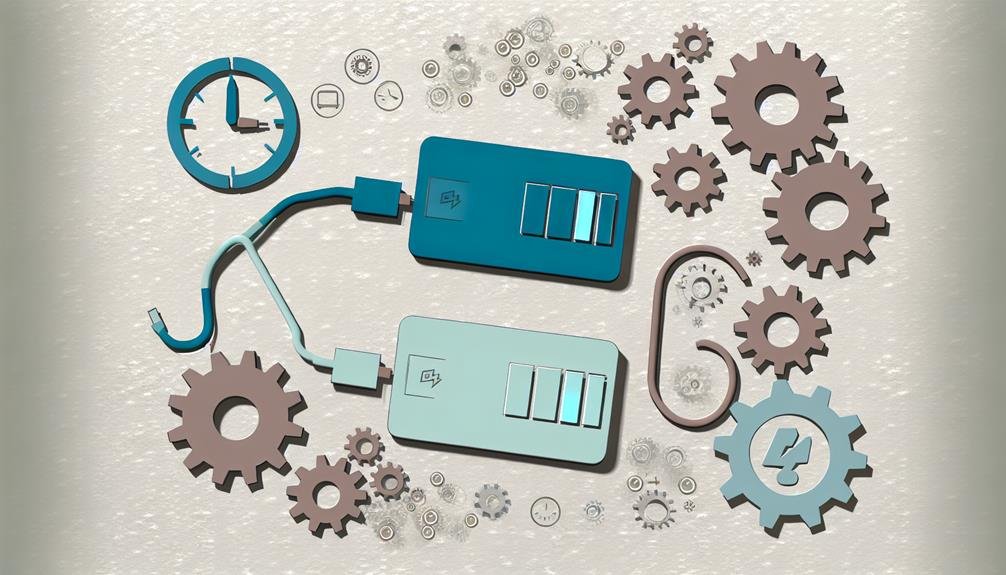
When charging a power bank with another power bank, you'll encounter significant energy transfer losses, reducing overall efficiency. This practice also accelerates battery degradation, potentially shortening the lifespan of both devices. Additionally, the charging cycle inefficiency means that more energy is wasted compared to charging directly from a reliable power source.
Energy Transfer Losses
In the process of charging one power bank with another, energy transfer losses are inevitable due to the inefficiencies inherent in the conversion and transmission of electrical energy. These losses stem from several factors that you should consider to maintain energy efficiency and avoid unnecessary power loss and battery drain.
Firstly, the conversion of energy from one power bank to another involves multiple stages of voltage regulation and current transformation. Each stage introduces a degree of energy loss.
Secondly, the cables and connectors used for charging play a critical role. High-resistance connections and subpar cables can exacerbate energy losses, further diminishing the efficiency of the charging process.
Lastly, the intrinsic charging limitations of the power banks themselves must be acknowledged. Most power banks are not designed to charge other power banks efficiently, leading to significant energy loss.
Consider these points:
- Voltage Regulation: Multiple stages of voltage adjustment lead to cumulative energy losses.
- Cable Quality: Substandard cables contribute to higher resistance and greater power loss.
- Device Compatibility: Power banks are not optimized for reciprocal charging, leading to inefficiency.
Battery Degradation Risks
Charging one power bank with another can accelerate battery degradation, greatly impacting overall effectiveness and lifespan. When you engage in this practice, the batteries in both power banks experience increased stress and wear. This stress can lead to a reduction in their overall capacity and efficiency, ultimately shortening their battery lifespan.
To illustrate the potential risks, consider the following table:
| Factor | Impact | Safety Concern |
|---|---|---|
| Increased Heat | Accelerated Degradation | Overheating Risk |
| Higher Load Cycles | Reduced Battery Lifespan | Shortened Usability |
| Energy Loss | Lower Efficiency | Inefficient Charging |
Increased heat generation is a significant factor. When one power bank charges another, both units tend to heat up more than usual. This heat can degrade battery materials faster, posing a risk of overheating. Additionally, the higher number of load cycles involved in this process leads to diminished capacity over time.
For those concerned with charging safety, it's essential to understand these risks. The reduced efficiency not only wastes energy but also requires more frequent recharges, contributing further to wear and tear. By avoiding unnecessary power bank-to-power bank charging, you can extend the lifespan of your devices and maintain peak safety standards.
Charging Cycle Inefficiency
Understanding the inefficiency inherent in charging one power bank with another can help you make more informed decisions about your charging habits. When you attempt to charge a power bank using another, several efficiency concerns come into play, primarily due to energy loss and charging compatibility issues.
Firstly, energy loss occurs because each power bank must convert stored energy into electrical current and then back into stored energy. This conversion process isn't 100% efficient, leading to wasted energy. Moreover, charging compatibility can be a significant issue. Not all power banks are designed to handle the input and output energy requirements efficiently, leading to further inefficiencies. Lastly, repeated charging cycles between power banks can accelerate battery degradation, reducing the overall lifespan of both devices.
To summarize the key points:
- Energy Loss: Converting energy back and forth between power banks results in significant inefficiencies.
- Charging Compatibility: Mismatched input/output specifications can exacerbate inefficiency.
- Battery Degradation: Repeated cycles of charging and discharging can shorten the lifespan of your power banks.
Potential Risks
You risk damaging both power banks due to potential overloading and overheating issues when attempting to charge one with the other. One primary concern is compatibility. Not all power banks are designed to charge or be charged in this manner, leading to charging limitations that can result in inefficiencies or even malfunctions. The internal circuitry of each power bank may not be equipped to handle the reciprocal charging process, thereby increasing the likelihood of short circuits or permanent damage to the units.
Furthermore, safety hazards are a significant concern. Overloading can occur if the power output and input specifications of the power banks are mismatched. This mismatch can cause excessive heat buildup, potentially leading to battery swelling, leakage, or even explosions in extreme cases. Performance issues are also notable; charging one power bank with another could degrade the battery cells more rapidly, reducing the overall lifespan and efficiency of both devices.
Safety Precautions
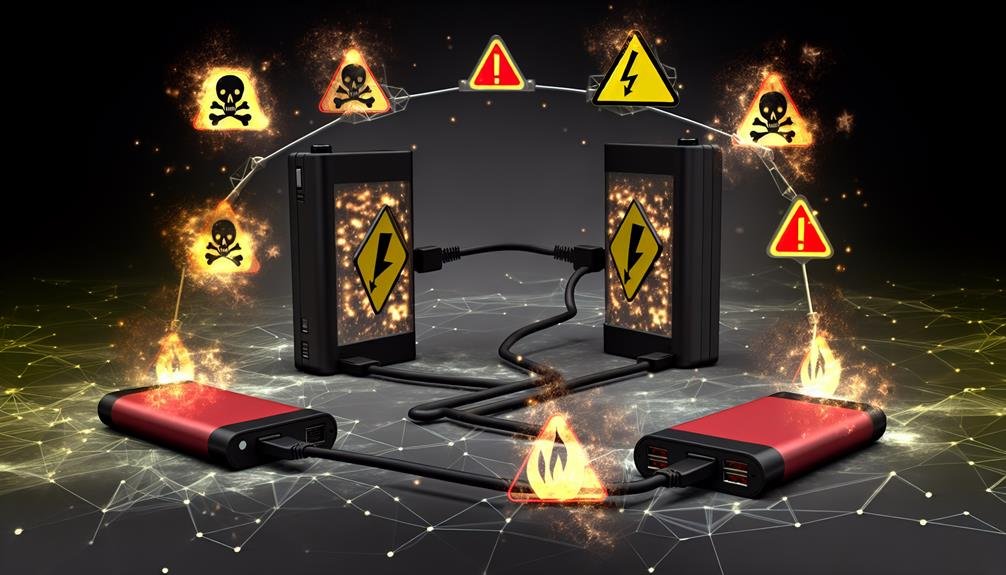
When charging a power bank with another power bank, make sure you avoid overloading the devices by checking their capacity and input/output specifications. Always use compatible cables to prevent potential short circuits or damage. This will help maintain safety and efficiency during the charging process.
Avoid Overloading Devices
To prevent overloading your devices, make certain that the combined output of the power banks doesn't exceed the safe charging capacity specified by the manufacturer. Understanding charging limitations is vital for maintaining power bank compatibility and guaranteeing device safety. When charging a power bank with another power bank, you must adhere to specific charging precautions to avoid damaging your devices or reducing their lifespan.
Here are three essential steps to follow:
- Check Specifications: Verify the output and input ratings of both power banks. Ensure that the total output does not surpass the device's maximum input rating. This avoids overloading and potential damage.
- Monitor Temperatures: During the charging process, keep an eye on the temperature of both power banks. Excessive heat can indicate overloading or inefficiency, which could compromise device safety.
- Use Appropriate Charging Cycles: Avoid continuous charging cycles without breaks. This practice can lead to overheating and reduce the overall efficiency and lifespan of your power banks.
Use Compatible Cables
Recommending the use of compatible cables is crucial for maintaining the integrity and safety of both power banks during the charging process. When selecting cables, pay close attention to cable compatibility with the power sources you are using. Incompatible cables can lead to suboptimal charging, overheating, or even damage to your devices. Always use cables that match the specifications recommended by the manufacturer to guarantee device compatibility.
Voltage regulation is another critical factor to keep in mind. Power banks typically operate within specific voltage ranges, and using a cable that doesn't support these parameters can cause voltage fluctuations. These fluctuations might not only reduce charging efficiency but can also pose safety risks. Verify that the cable is rated for the voltage and current levels specified for both power banks involved.
You should also assess the build quality of the cable. Poorly constructed cables can fray, break, or lose connectivity, increasing the risk of short circuits or other electrical hazards. By prioritizing high-quality, compatible cables, you're safeguarding both your power banks and ensuring efficient, stable power transfer. Always check for certification marks that indicate compliance with industry standards for additional assurance.
Battery Health Impact
Charging one power bank with another can greatly impact battery health due to the inefficiencies and heat generation involved in the process. When you connect two power banks, the energy transfer isn't 100% efficient. This inefficiency can lead to excessive heat, which directly affects battery longevity. Frequent charging cycles between power banks can also accelerate the wear and tear of the batteries, reducing their overall lifespan.
Consider the following points to understand the impact on battery health:
- Heat Generation: Excessive heat from inefficient energy transfer can degrade battery cells, leading to reduced performance and potential failure.
- Charging Frequency: Increased charging frequency between power banks compounds the wear on each unit, shortening their effective lifespans.
- Energy Loss: The inefficient transfer process results in significant energy loss, which means you're not only risking battery health but also wasting valuable power.
It's important to be aware of these factors to maintain the safety and longevity of your devices. Always prioritize proper charging practices to make sure your power banks remain reliable and efficient. By understanding these technical details, you can make informed decisions that safeguard your battery's longevity and overall performance.
Alternative Solutions
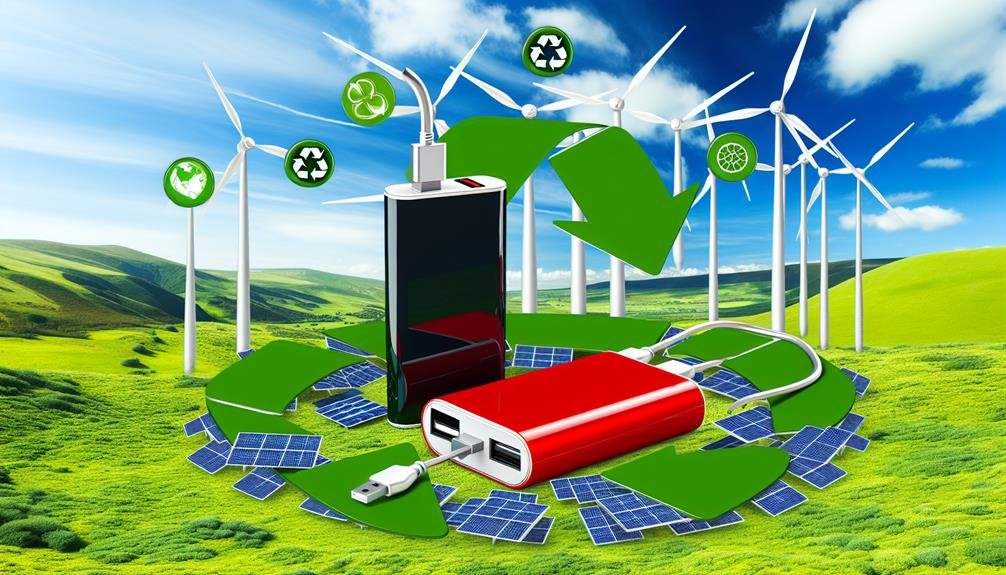
Instead of charging one power bank with another, consider utilizing a wall outlet or a solar charger to guarantee efficient and safe energy transfer. Using a wall outlet assures that your power bank receives a stable voltage and current, minimizing charging limitations. Wall outlets are designed for high-capacity energy transfer, making them the most reliable method. Solar chargers offer an eco-friendly alternative, especially useful in outdoor or off-grid scenarios. These chargers convert sunlight into electrical energy, providing a renewable power source without compatibility issues.
Charging a power bank with another introduces several compatibility issues and safety concerns. Different power banks may have varying voltage and current ratings, leading to inefficient energy transfer and potential damage. Additionally, connecting two power banks can create a feedback loop, where the energy continuously cycles between the devices, causing overheating and reducing battery life.
Best Practices
To maximize the lifespan and efficiency of your power bank, adhere to best practices that promote safe and peak charging. Ensuring charging compatibility and addressing safety concerns should be paramount in your routine. Here are key points to keep in mind:
- Verify Charging Compatibility: Always use cables and adapters that match the power specifications of your power bank. Mismatched equipment can lead to inefficient charging and potential safety hazards. Confirm that the input and output voltages are compatible to avoid damage.
- Monitor Power Bank Capacity and Charging Speed: Be mindful of your power bank's capacity and the charging speed it supports. Overloading a power bank beyond its rated capacity can degrade its battery life. Use chargers that align with the recommended charging speed to optimize efficiency and longevity.
- Implement Safe Charging Practices: To mitigate safety concerns, avoid charging your power bank unattended or in extreme temperatures. Excessive heat or cold can negatively impact the internal battery chemistry, leading to reduced performance or even hazards like swelling or leakage.
Frequently Asked Questions
Can Charging a Power Bank With Another Power Bank Cause Overheating?
Did you know 20% of electronics fail due to overheating? Charging a power bank with another can raise safety concerns, causing overheating and reducing charging efficiency. Always check compatibility to guarantee safe and efficient charging.
How Does the Charging Speed Compare Between Different Power Bank Models?
When comparing charging speeds, you'll notice significant speed variations in power banks. Charging efficiency comparison depends on factors like output wattage and battery technology. Always choose a reputable brand to guarantee safety and best performance.
Are There Specific Brands That Support Power Bank-To-Power Bank Charging?
Ever wondered if some brands support power bank-to-power bank charging? You'll find that not all do. Compatibility concerns and brand comparisons are vital. Charging efficiency varies, and safety precautions are essential. Research thoroughly before deciding.
What Are the Common Signs of a Damaged Power Bank?
You'll notice signs of a damaged power bank if the charging indicator malfunctions, it doesn't hold charge, or there's unusual heat during operation. These issues suggest potential safety hazards and warrant immediate attention.
Can Power Bank-To-Power Bank Charging Void Warranties?
Imagine a telegram warning: Yes, charging a power bank with another can void warranties due to compatibility issues, safety concerns, and charging efficiency problems. Always check your warranty's fine print and adhere to manufacturer guidelines to stay protected.

